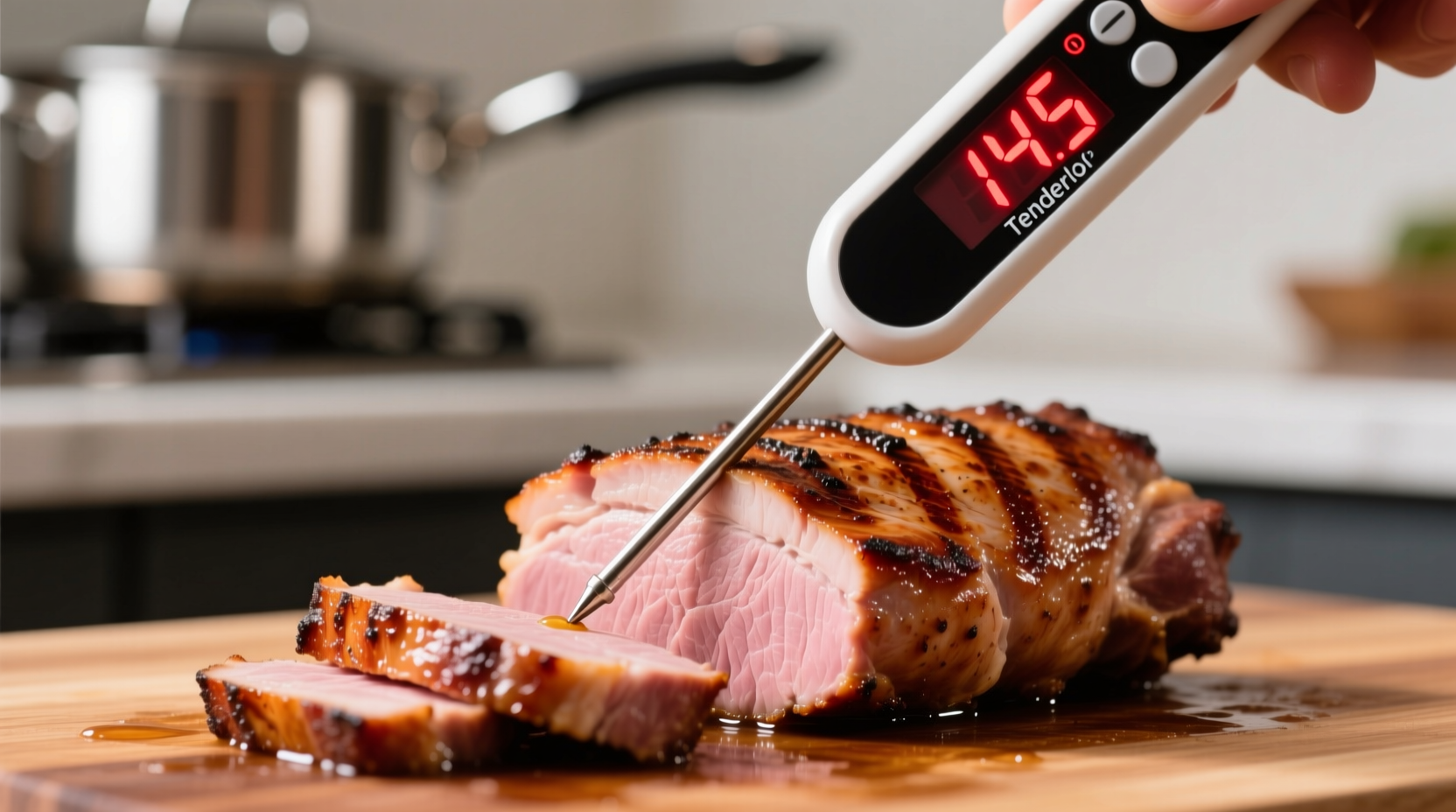The perfect internal temperature for cooking pork tenderloin is 145°F (63°C) measured with a food thermometer in the thickest part, followed by a mandatory 3-minute rest period. This USDA-approved standard ensures both food safety and optimal juiciness, allowing pork to remain slightly pink while eliminating harmful pathogens.
Why Precise Temperature Matters for Pork Tenderloin
Getting the temperature right for pork tenderloin isn't just about following rules—it's the difference between succulent perfection and dry disappointment. Unlike tougher cuts that benefit from long cooking, tenderloin's delicate muscle fibers dry out quickly when overheated. The USDA's 145°F guideline with 3-minute rest represents a scientific sweet spot where trichinella parasites are eliminated while preserving moisture.
Many home cooks still default to the outdated 160°F recommendation, resulting in overcooked, chewy meat. Modern pork production has virtually eliminated trichinosis risks in commercial pork, allowing for lower safe temperatures. This shift reflects decades of agricultural advancements documented in the USDA Food Safety and Inspection Service guidelines.
Temperature Science: Beyond the Numbers
Understanding what happens inside your pork at different temperatures transforms cooking from guesswork to precision:
| Temperature Range | Protein Transformation | Visual & Texture Changes |
|---|---|---|
| 120-130°F | Myosin begins denaturing | Rare: Very juicy, deep red-pink |
| 135-140°F | Actin starts coagulating | Medium-rare: Warm pink, slightly firm |
| 145°F + 3-min rest | Pathogens eliminated | Medium: Light pink, tender, juicy (USDA safe) |
| 150-160°F | Excessive moisture loss | Medium-well: Grayish, noticeably drier |
| 165°F+ | Complete protein contraction | Well-done: Dry, tough, crumbly texture |
This molecular transformation explains why temperature control trumps cooking time estimates. A 1-inch thick tenderloin might reach 145°F in 15 minutes at 400°F, while a 2-inch cut could take 25 minutes—making thermometer use non-negotiable.

Your Step-by-Step Perfect Pork Protocol
Preparation Essentials
Remove tenderloin from refrigerator 30 minutes before cooking. Pat completely dry with paper towels—moisture prevention ensures proper searing. Season generously, then create a temperature-friendly cooking environment:
- Oven method: Preheat to 400°F with rack in center position
- Grill method: Establish two-zone fire (direct/indirect heat)
- Sous vide: Set to 140°F for medium-rare finish
Temperature Monitoring Technique
Insert an instant-read thermometer into the thickest part, avoiding fat pockets or bones. Check temperature 5 minutes before expected finish time, then monitor every 2 minutes as you approach 140°F. Remove meat at 140°F—the residual heat will carry it to 145°F during resting.
The Critical Resting Phase
Transfer to a cutting board, tent loosely with foil, and wait exactly 3 minutes. This allows:
- Temperature equalization throughout the meat
- Protein fibers to relax and reabsorb juices
- Carryover cooking to complete the process
Avoiding Common Temperature Pitfalls
Why Your Pork Might Still Be Dry
Even at 145°F, dry pork happens when:
- Resting time is skipped (juices spill out during slicing)
- Thermometer wasn't calibrated (verify with ice water test)
- Cooking surface was insufficiently preheated (steaming vs. searing)
Addressing Pink Color Concerns
Naturally occurring myoglobin retains pink hues up to 148°F in some pork. Don't rely on color—always use a thermometer. The CDC confirms that proper temperature eliminates trichinella regardless of color appearance.
Cooking Method Adjustments
While the target temperature remains constant, cooking approaches vary:
- High-heat sear (400°F+): 15-20 minutes total, check at 12 minutes
- Low-and-slow (275°F): 25-35 minutes, requires closer monitoring
- Grill direct heat: 8-10 minutes per side, move to indirect if browning too fast
- Sous vide finish: Sear 60 seconds per side after 1-2 hour bath
Always verify with a thermometer regardless of method—time estimates vary significantly based on starting temperature, meat thickness, and equipment calibration.
Food Safety Context Matters
The 145°F standard applies to intact muscle cuts like tenderloin. Ground pork requires 160°F due to increased surface area exposure. Immunocompromised individuals or pregnant women may choose to follow the slightly more conservative 150°F guideline, though this remains well within safe parameters according to FDA Food Code standards.
Historically, pork cooking temperatures evolved significantly:
- Pre-1990s: 170°F standard due to trichinosis concerns in non-commercial pork
- 1990s-2011: Reduced to 160°F as commercial farming improved
- 2011-Present: USDA adopts 145°F + 3-minute rest based on modern safety data
This progression reflects improved agricultural practices and pathogen monitoring, making today's pork safer than ever while allowing for better eating quality.
Mastering Temperature Control
Professional results require the right tools:
- Digital instant-read thermometer: Thermapen or comparable (calibrate monthly)
- Oven thermometer: Verify actual oven temperature differs from setting
- Resting timer: Essential for the mandatory 3-minute pause
Invest in a leave-in probe thermometer for stress-free monitoring during longer cooks. Remember that carryover cooking adds 5-10°F during resting—pulling at 140°F prevents overshooting your target.











 浙公网安备
33010002000092号
浙公网安备
33010002000092号 浙B2-20120091-4
浙B2-20120091-4